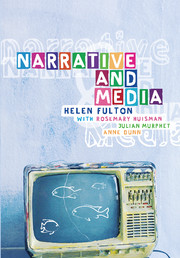Book contents
- Frontmatter
- Contents
- Figures and tables
- Contributors
- Acknowledgements
- 1 Introduction: the power of narrative
- Part 1 The basics of narrative theory
- Part 2 Film as narrative and visual mode
- 4 Stories and plots
- 5 Narrative time
- 6 Narrative voice
- 7 Point of view
- 8 Novel to film
- 9 Film narrative and visual cohesion
- Part 3 Television: narratives and ideology
- Part 4 Radio and print journalism
- Part 5 Popular print culture
- Glossary
- Bibliography
- Index
5 - Narrative time
Published online by Cambridge University Press: 05 June 2012
- Frontmatter
- Contents
- Figures and tables
- Contributors
- Acknowledgements
- 1 Introduction: the power of narrative
- Part 1 The basics of narrative theory
- Part 2 Film as narrative and visual mode
- 4 Stories and plots
- 5 Narrative time
- 6 Narrative voice
- 7 Point of view
- 8 Novel to film
- 9 Film narrative and visual cohesion
- Part 3 Television: narratives and ideology
- Part 4 Radio and print journalism
- Part 5 Popular print culture
- Glossary
- Bibliography
- Index
Summary
To begin with the very obvious, all storytelling is necessarily extended in time: narrative is a temporal mode. To tell a story is to articulate represented events in a sequence, putting one thing after another, drawing causal connections between them, until we have moved (as Aristotle said) from beginning, to middle, to end. And this takes time; it occupies and could even be said to ‘flesh out’ time. Narrative has generally been thought of as a pleasurable way of spending time, or filling it, and from time to time we are even conscious of going to the movies to ‘kill time’. From the moment our caregivers start telling us bedtime stories, we are woven into narrative textures and use these textures to orient us in our daily experience of time. The fact is that our very notion of time, the way we represent it intimately to ourselves, is entirely bound up with the forms of narrative to which we have been exposed. Try to imagine your own personal history ‘outside’ some kind of narrative shape; the closest you can get is a set of simultaneously juxtaposed images, from which precisely the element of time is missing. Narrative is the medium in which we ‘think time’, although it might as well be said that time itself, if we can imagine it outside human consciousness, has nothing narrative about it.
- Type
- Chapter
- Information
- Narrative and Media , pp. 60 - 72Publisher: Cambridge University PressPrint publication year: 2005
- 1
- Cited by



